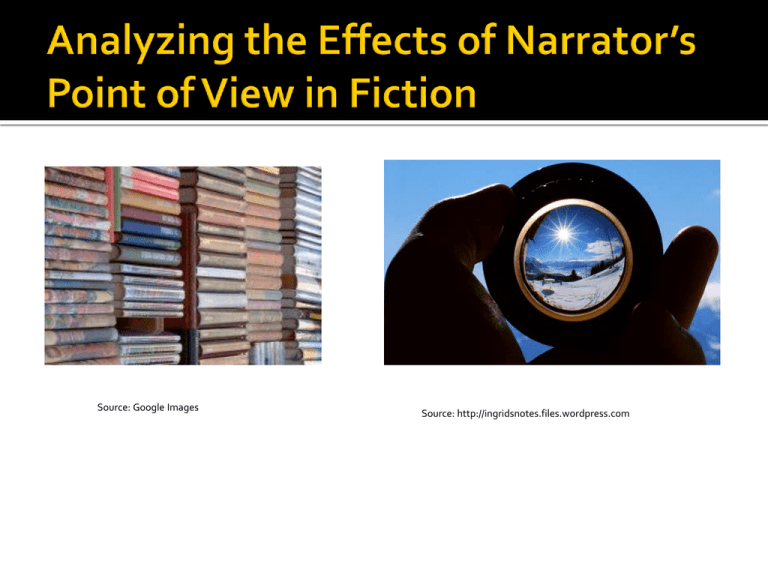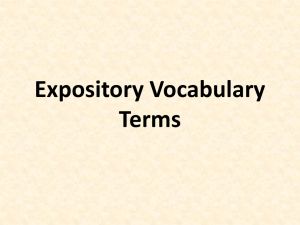Point of View - WordPress.com
advertisement

Source: Google Images Source: http://ingridsnotes.files.wordpress.com Like a photographer who switches lenses to vary the view of an object, a writer chooses a method of narration that can reveal, to a varying degree, what is happening with in a story. When studying the perspective of the narrator, the reader is concerned with the relationship between the person telling the story (the narrator) and the agents referred to by the story teller (the characters). Point of view refers to the method of narrating. The three most common points of view include: first-person, third-person omniscient and third-person limited. Source: Google Images 1. 2. 3. 4. 5. 6. First-Person Second-Person Third-Person Third-Person Objective Third-Person Limited Third-Person Omniscient Source: Google Images Source: Google Images 1. The distance of the narrator from the story. 2. How much the narrator reveals about the thoughts and feelings of the characters. ‘I’ is telling the story. The camera lens is firmly behind the narrating character’s eyes, and the reader only sees what the narrating character sees and knows. The narrator is usually the main character/protagonist. Readers should watch for: I, me, my, our, we, myself and ourselves. Source: http://this iscolossal.com It’s easy for readers to get into the head of the protagonist. Readers can (many times) identify with him/her. There’s an immediacy and intimacy between the reader and the protagonist. It’s easier to share the protagonist’s thoughts and feelings and emotions. The writer can only use scenes that directly involve the protagonist. It’s harder for the narrator to describe him or herself naturally. First person narrators cannot always be trusted to examine a situation honestly. They may be blind to their own faults. Source: http://www.writingwildly.com/blog.html “It was a bad summer, and we all knew it. We liked to phrase it that way, as if what was happening was an aberration –a single season of pain and doubt- instead of all-out informing people that our lives were falling apart, plain and simple as pie. I knew too much for someone who was fifteen…” --“Local Girls”– by Alice Hoffman What happens if you changes the point of view to third person-limited? Harper Lee's To Kill a Mockingbird is told from the point of view of Scout, a young child. She doesn't grasp the complex racial and socioeconomic relations of her town — but the reader does, because Scout gives information that the reader can interpret. Also, Scout's innocence reminds the reader of a simple, "it's-not-fair" attitude that contrasts with the rationalizations of other characters. Rare Because it connects directly with the reader, consider the intended audience when you read a secondperson piece. What is said to the reader gives some idea of the reader’s personality, beliefs and issues. Example: You woke up in the middle of the night and had no idea why. Suddenly, you heard a strange tapping noise. For a moment you thought it might be… Source: Google Images Characters are described by a narrator outside the action. The writing is about a subject. The author discusses a subject without injecting any personal pronouns, such as I, me, my, our or we. Authors enter into characters’ minds and reveal their thoughts. Types: Objective, Limited, Omniscient The narrator tells the story from only one character’s perspective. All the reader knows is what the narrator reveals of the character’s thoughts, feelings, observations and experiences. “Every night that winter he said aloud into the dark of the pillow: Half-past four! Half-past four! Till he felt his brain had gripped the words and held them fast. Then he fell asleep at once, as if a shutter had fallen…” --“A Sunrise on the Veld” by Doris Lessing-- If the point of view changed, how would this alter the story’s beginning? “Simple Maria believed in love. That was what made her a living legend. All her neighbors came to her funeral, even the police and the blind man from the kiosk who almost never abandoned his business…” --“Simple Maria” by Isabel Allende— How does this narrators point of view affect your perception of the character –based on what you have read so far? The narrator is all-knowing, and can see into the minds of more than one character. This point of view, which is the most established, was used by Chaucer in the 14th century and by the early novelists of the 18th century. Allows writers the freedom to reveal a variety of information about a number of characters. Narrator can see into the past and into the future. Narrator relates characters’ thoughts and comments on events. Writer can make comments about the character and their motivations. Source: Google Images “In the own of –(no matter where) there circulated two local news papers (no matter when). Now the Flying Post was longestablished and respectable –alias bigoted and Tory; the Examiner was spirited and intelligent –alias newfangled and democratic. Every week, these newspapers contained articles abusing each other…” --“Christmas Storms and Sunshine”-- Why do you think the writer chose thirdperson omniscient point of view for this fictional story? If the point of view changed, how would that alter the story’s effectiveness? Consider the point of view in fiction. What is this point of view influenced by? – culture, ethnicity, family values, economic status, biases??? 3. Content is crucial. The author may be arguing for a particular solution or may be examining a controversial issue. What the author says,may tell you what he or she believes. 4. Much about the author’s point of view is implied, not stated. 1. 2. See what insights you gain about a narrator by observing how other characters respond to him or her. Be aware that a point of view can shift in some stories. Draw conclusions about the narrator. Is he or she always reliable? What personal flaws or ulterior motives might the narrator reveal, even unconsciously? Infer why the writer chose a particular point of view. Challenge yourself to explore how the story might be different if told from another perspective? Think about the narrator's perspective. Think about elements, such as gender, age, nationality or anything else. For "objective" narrators, consider biases that the narrator has, who he or she decides to focus on and anything else that indicates a subjective point of view. Keep in mind that authors deliberately select characters in a literary work to achieve an overall effect upon the reader. How does the point of view of Poe's protagonist in "The Tell-Tale Heart" contribute to the suspenseful tone? If this story was written from another perspective, would it be as effective at conveying the theme of guilt? unreliable first-person narrators- This means that they either can't or won't tell us what really happened. Narrator talks directly to readers, which serve as his or her audience. The narrator tries to justify how he is not mad. This helps the readers to identify with the narrator, as any kind of normal person on the same level, who simply went crazy. If this story had been written in another point of view, it would have not been effective in conveying the themes of guilt, perverseness or human wickedness. Point of view is important to any story, because it can help create the mood, and setting of a piece. "The Tell-Tale Heart" is a good example of this. In this story, Poe uses first-person point of view to create suspense and tension, while letting the reader try to discover the thoughts of the narrator. “As in many of his other short stories, Poe does not name the narrator. A possible explanation for this is that the unnamed narrator becomes every human being, thereby enhancing the universality of the short story. In other words, the narrator represents anyone who has ever acted perversely or impulsively–and then had to pay for his deed. “-Michael J. Cummings



